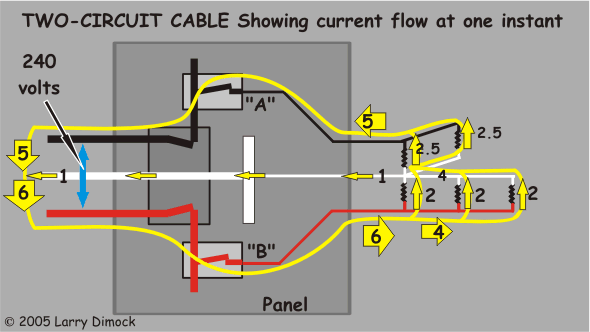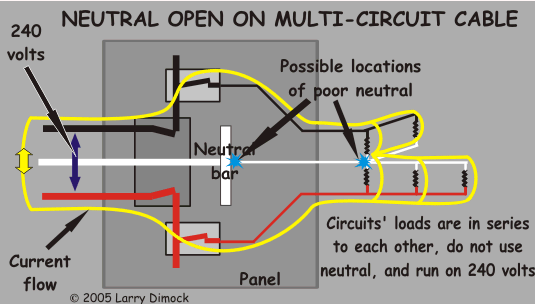Two-Circuit Cables:
Double Trouble
A particular kind of circuitry often found in U.S. and Canadian homes mirrors the main wiring feeding the home from the power company. It is called a multiwire branch circuit but for our purposes it would be clearer to call it a two-circuit cable. It involves two hot wires sharing one neutral as their "return" path. The hot wires are 240 volts apart from each other and each is 120 volts from the neutral. This sort of arrangement saves a little wire and labor at installation time by using a cable containing black, red, and white wires between the panel and (usually just) the first outlet or switch box it is run to.
The two parts of this multi-circuit usually split apart from each other at that point and then behave like most other 120-volt circuits. But if you were to trace the flow of two-circuit current from the panel to that first box at a time when each part of the multicircuit was using different amounts of electricity, here is what you would find:

If 5 amps is flowing on hot wire A and 6 amps on hot wire B, the neutral path they share will not be found to be carrying 11 amps (as it would if the hots were, against code, fed from the same main wire through the same busbar). Instead, 1 amp would be flowing on the neutral, and at a given instant (remember this is alternating current) it would be flowing in the direction that would seem to complete the motion of current in wire B, and against the direction that would seem needed to complete wire A's circuit. Where is A's 5 amps of current "coming from" or "going to" at that instant? It is not connecting to the panel by way of the neutral; it is by way of wire B, driven by the 240 volts between them. Even wire B is sending 5 of its amps along wire A, with the 1 amp difference -- the imbalance -- going on the neutral. A's 5 amps and 5 of B's 6 amps are the same thing -- they are essentially a 240-volt circuit at that point, flowing from breaker to breaker and ultimately out to the two ends of the power company transformer's coil. The whole system for the home is doing this all the time because the two hot main power company wires share one neutral from the panel back to the transformer.
There is a disturbing malfunction that can occur with a multi-circuit cable at the panel or a box it goes to.

If the neutral connection at the panel's neutral bar or at a box the cable is run to goes bad, the two circuits will become entirely one 240-volt circuit, with one (former) circuit's set of loads arranged in series with the other's. And since their lights and appliances were not designed with such a voltage and connection scheme in mind, the result is that the items served by one former circuit will tend to run brighter than usual and those of the other dimmer. Damage can occur, especially to sensitive electronic equipment. If you notice a sustained weird dimming of lights in one part of the home and lights burning brighter than normal in another part, this is one possible cause. The other possibility is a similar situation occurring to the home's whole system when the Main neutral is bad.
Double-circuit Outlets
The kitchen/dining area of U.S. homes wired in the 1960s (and a little before and after; also some family rooms during that time) often had two distinct 20-amp "appliance" circuits reaching each normal (duplex) receptacle by way of two-circuit cable. [Canada's version has been to require single-circuit 20-amp and/or two-circuit 15-amp receptacles at specified kitchen locations]. The idea was to distribute heavy loads more easily between the two required circuits. The fact that homeowners and home-dwellers were unaware of this made the idea almost useless, in my opinion. Anyway, by now this well-meaning idea has even backfired:
When homeowners or handymen now replace even just one of these worn or unfashionable receptacles without breaking away the metal tab that connects top and bottom halves of the hot side, the two circuits, which were purposely fed from opposite main busbars to let them share one neutral without overloading it, will pass a 240-volt short between them. If the breaker handles of the two circuits are tied together, as would be required by now, they will both trip, and someone will have to figure out what was done wrong. More often, the breakers are quite separate and the first one to trip thereby prevents the second from tripping. This actually leaves all the outlets still working because the circuit that didn't trip now feeds its hotness through the unremoved metal tab to the other half of all the outlets. This means that the whole kitchen will now have only one circuit's load capacity, instead of two. I have seen homes where one of these breakers has apparently been sitting tripped for years, with people wondering why they can't run more than two appliances at once in their kitchen before the (good) breaker trips from an overload.
"For the last 3 months off & on, my father in law and 'in-house electrician' have attempted to find/solve the problem. While they have found other issues and corrected them, they still were not able to fix the root cause. After doing some preliminary check of my own, I consulted with Google, and I found your website. My lucky day! After using your trouble shooter, I determined that he had an open neutral. Armed with that info, I shut off the main power, went straight to the neutral lugs in a splice box and tightened them up (and boy were they loose. Over 2 turns on one of them!) Checked a couple others that were tight, and restored power. The problem was fixed 'instantly.' So, within 3 hours I had the problem corrected!!! Payment to 'electrician' to fix problems: $550. Amount of damaged motors and refrigeration equipment: $2250. Seeing look on Father-in-laws face when his know-it-all son-in-law fixed the problem: priceless! Thank you from both of us!!!!" -Jerry, MI